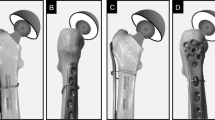Abstract
Introduction
As there are few reports on the difficulties of removing the locking compression plate (LCP), we prospectively investigated the incidence and difficulties in 58 patients in whom various types of LCPs were taken.
Methods
From January 2004 to December 2007, we have removed 159 5.0-self tapping locking screws and 279 3.5- self tapping locking screws. All of the operations were performed by experienced trauma surgeons. All of the screws were inserted with the use of torque limiting attachment according to the manufacturer’s recommendation. During the same period of time we have removed 198 AO-3.5 cortical and 4.0 cancellous screws from various sites.
Results
All of 159 5.0-self tapping locking screws were removed without difficulties. A total of 24 out of 279 3.5- self tapping locking screws were removed with many difficulties due to the stripping of the hexagonal recess. The use of conical extraction screw which was developed especially for the removal of stripped locking screws was successful in only six screws. We have removed plates by cutting the plate with metal cutting saw. We describe useful technical trick to remove the plate when there is only one screw left stripped. Compared to the locking screws, only one of 198 3.5-cortical screws was stripped.
Conclusion
Care should be taken at the time of removal of the locking compression plate, especially for the 3.5-locking screws.




Similar content being viewed by others
References
Bjorkenheim JM, Pajarinen J, Savolainen V (2004) Internal fixation of proximal humeral fractures with a locking compression plate: a retrospective evaluation of 72 patients followed for a minimum of 1 year. Acta Orthop Scand 75:741–745. doi:10.1080/00016470410004120
Cole PA, Zlowodzki M, Kregor PJ (2004) Treatment of proximal tibia fractures using the less invasive stabilization system: surgical experience and early clinical results in 77 fractures. J Orthop Trauma 18:528–535. doi:10.1097/00005131-200409000-00008
Frigg R (2001) Locking Compression Plate (LCP). An osteosynthesis plate based on the Dynamic Compression Plate and the Point Contact Fixator (PC-Fix). Injury 32(Suppl 2):63–66. doi:10.1016/S0020-1383(01)00127-9
Frigg R (2003) Development of the Locking Compression Plate. Injury 34(Suppl 2):B6–B10. doi:10.1016/j.injury.2003.09.020
Gautier E, Sommer C (2003) Guidelines for the clinical application of the LCP. Injury 34(Suppl 2):B63–B76. doi:10.1016/j.injury.2003.09.026
Georgiadis GM, Gove NK, Smith AD, Rodway IP (2004) Removal of the less invasive stabilization system. J Orthop Trauma 18:562–564. doi:10.1097/00005131-200409000-00014
Hamilton P, Doig S, Williamson O (2004) Technical difficulty of metal removal after LISS plating. Injury 35:626–628. doi:10.1016/S0020-1383(03)00097-4
Hertel R, Pisan M, Lambert S, Ballmer FT (1996) Plate osteosynthesis of diaphyseal fractures of the radius and ulna. Injury 27:545–548. doi:10.1016/S0020-1383(96)00091-5
Kaab MJ, Frenk A, Schmeling A, Schaser K, Schutz M, Haas NP (2004) Locked internal fixator: sensitivity of screw/plate stability to the correct insertion angle of the screw. J Orthop Trauma 18:483–487. doi:10.1097/00005131-200409000-00002
Korner J, Lill H, Muller LP, Rommens PM, Schneider E, Linke B (2003) The LCP-concept in the operative treatment of distal humerus fractures—biological, biomechanical and surgical aspects. Injury 34(Suppl 2):B20–B30. doi:10.1016/j.injury.2003.09.022
Kregor PJ, Stannard JA, Zlowodzki M, Cole PA (2004) Treatment of distal femur fractures using the less invasive stabilization system: surgical experience and early clinical results in 103 fractures. J Orthop Trauma 18:509–520. doi:10.1097/00005131-200409000-00006
Langkamer VG, Ackroyd CE (1990) Removal of forearm plates. A review of the complications. J Bone Joint Surg Br 72:601–604
Musgrave DS, Idler RS (2005) Volar fixation of dorsally displaced distal radius fractures using the 2.4-mm locking compression plates. J Hand Surg [Am] 30:743–749. doi:10.1016/j.jhsa.2005.03.006
Pattison G, Reynolds J, Hardy J (1999) Salvaging a stripped drive connection when removing screws. Injury 30:74–75. doi:10.1016/S0020-1383(98)00207-1
Perren SM (2001) Evolution and rationale of locked internal fixator technology. Introductory remarks. Injury 32(Suppl 2):B3–B9. doi:10.1016/S0020-1383(01)00120-6
Perren SM (2002) Evolution of the internal fixation of long bone fractures. The scientific basis of biological internal fixation: choosing a new balance between stability and biology. J Bone Joint Surg Br 84:1093–1110. doi:10.1302/0301-620X.84B8.13752
Ring D, Kloen P, Kadzielski J, Helfet D, Jupiter JB (2004) Locking compression plates for osteoporotic nonunions of the diaphyseal humerus. Clin Orthop Relat Res 50–54. doi:10.1097/01.blo.0000131484.27501.4b
Sanderson PL, Ryan W, Turner PG (1992) Complications of metalwork removal. Injury 23:29–30. doi:10.1016/0020-1383(92)90121-8
Schutz M, Muller M, Regazzoni P, Hontzsch D, Krettek C, Van der Werken C et al (2005) Use of the less invasive stabilization system (LISS) in patients with distal femoral (AO33) fractures: a prospective multicenter study. Arch Orthop Trauma Surg 125:102–108. doi:10.1007/s00402-004-0779-x
Sommer C (2003) Locking Compression Plate. Injury 34(Suppl 2):B4–B5. doi:10.1016/j.injury.2003.09.019
Sommer C, Babst R, Muller M, Hanson B (2004) Locking compression plate loosening and plate breakage: a report of four cases. J Orthop Trauma 18:571–577. doi:10.1097/00005131-200409000-00016
Sommer C, Gautier E, Muller M, Helfet DL, Wagner M (2003) First clinical results of the Locking Compression Plate (LCP). Injury 34(Suppl 2):B43–B54. doi:10.1016/j.injury.2003.09.024
Stoffel K, Dieter U, Stachowiak G, Gachter A, Kuster MS (2003) Biomechanical testing of the LCP—how can stability in locked internal fixators be controlled? Injury 34(Suppl 2):B11–B19. doi:10.1016/j.injury.2003.09.021
Wagner M (2003) General principles for the clinical use of the LCP. Injury 34(Suppl 2):B31–B42. doi:10.1016/j.injury.2003.09.023
Acknowledgment
This study was supported by a grant of the Korea Health 21 R&D Project, Ministry of Health and Welfare, Republic of Korea (Grant A060465).
Author information
Authors and Affiliations
Corresponding author
Rights and permissions
About this article
Cite this article
Bae, JH., Oh, JK., Oh, CW. et al. Technical difficulties of removal of locking screw after locking compression plating. Arch Orthop Trauma Surg 129, 91–95 (2009). https://doi.org/10.1007/s00402-008-0769-5
Received:
Published:
Issue Date:
DOI: https://doi.org/10.1007/s00402-008-0769-5




